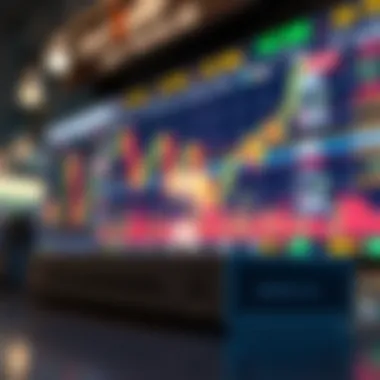Understanding Forex Options Quotes: A Complete Guide


Intro
Navigating the foreign exchange market can feel like stepping into a whirlwind, especially with options trading as part of the package. The term ‘forex options quotes’ may seem overwhelming at first glance, but breaking it down into manageable pieces can be illuminating. These quotes serve as the compass for traders, guiding their decision-making process and buffering their strategies against unforeseen market shifts.
Forex options quotes are a uniquely structured type of data that informs traders about the potential outcomes related to currency pair movements. Understanding them not only involves grasping how these quotes are formatted but also comprehending the underlying market dynamics that influence their fluctuations. It's akin to reading a map; if you can interpret the markings, navigating becomes far less daunting.
To truly leverage the forex options market, it's essential to become acquainted with the language of finance— terminology and jargon that seems convoluted to the uninitiated. This initial foray into the labyrinth of quotes will set the stage for a deeper dive into their practical applications and strategic importance.
We’ll dive into key concepts and useful terms in the investment dictionaries, then pivot to a thorough financial product review, addressing how these options stack up in comparison to traditional forex trading. Both sections will aim to equip investors, financial advisors, students, analysts, and coaches with a thorough understanding tailored to their needs, allowing for more informed trading decisions all-around.
Investment Dictionaries
Key Financial Terms
In any arena of finance, having a firm grasp of the vocabulary is crucial. Here’s a collection of essential terms related to forex options quotes that every trader should know:
- Call Option: A contract giving the holder the right, but not the obligation, to purchase a currency pair at a predetermined price before a specified date.
- Put Option: This is the flip side of the call option, allowing the holder the right to sell a currency pair under similar conditions.
- Strike Price: The agreed-upon price at which the currency can be bought or sold when exercising an option.
- Expiration Date: The last date on which the option can be exercised. After this date, the option becomes void.
- Premium: The fee paid to purchase the option. This can vary based on several factors including volatility and strike price distance.
Understanding these terms is more than just memorization; it’s about building a foundation. Getting comfortable with this jargon helps demystify conversations around forex trading and opens doors to deeper strategic insights.
Investment Jargon Explained
Investment language can sometimes feel like a foreign dialect. Here are a few phrases often tossed around that can trip up even seasoned traders:
- In-the-Money (ITM): A call option is ITM if the market price is above the strike price, while a put option is ITM if the market price is below the strike price.
- Out-of-the-Money (OTM): This refers to call options that sit below the strike price and put options above the strike price.
- Implied Volatility: A metric reflecting the market’s forecast of a likely movement in a currency’s price.
Gaining fluency in these terms enhances your capability to communicate with other investors and navigate complex discussions surrounding forex options.
The forex market is vast, and understanding options quotes is the proverbial tip of the iceberg. Once you grasp this essential component, the much larger picture of trading strategies and market analysis unfolds before you.
Financial Product Reviews
Comparative Analysis of Products
When it comes to forex options, not all products are created equal. Various platforms offer different features that cater to distinct trading needs. Here’s a basic comparison of a few popular options trading platforms:
- MetaTrader 4: Known for its user-friendly interface and extensive analytical tools, but lacks advanced options trading capabilities.
- Thinkorswim by TD Ameritrade: Offers a plethora of options trading tools and an educational platform, making it ideal for both novices and experienced traders.
- NinjaTrader: Focuses on robust trading technology with customizable tools, yet may pose a steeper learning curve for beginners.
Pros and Cons Evaluation
When considering forex options, weighing the benefits against the potential drawbacks is vital. Here are some pros and cons:
Pros:
- Flexibility: Options allow traders to customize their strategies by providing various expiration dates and strike prices.
- Leverage: Traders can control larger positions with a smaller amount of capital, enhancing potential returns.
Cons:
- Complexity: Navigating the world of options can present a steep learning curve for those new to trading.
- Risk of Premium Loss: If an option expires worthless, investors lose the premium paid, which can be a hard hit.
Identifying these factors can significantly enhance a trader's ability to approach the market methodically and strategically.
With a clearer understanding of forex options quotes and their impacts on trading strategy, the discussion will continue to dig into how market forces shape quotes and what to consider when integrating them into your trading narrative.
Prolusion to Forex Options Quotes
Forex options quotes are a crucial aspect of financial trading, particularly in the vast realm of currency exchange. Understanding these quotes provides traders with a window into the mechanics of options trading and offers vital insights for making informed decisions. The significance of these quotes cannot be overstated, as they serve not only as indicators of market sentiment but also as essential tools for crafting tailored trading strategies.
Definition of Forex Options
Forex options are contracts that confer the right, but not the obligation, to buy or sell a specified amount of currency at a predetermined price, on or before a certain date. This financial instrument allows traders to hedge against potential losses or speculate on market movements without the necessity of holding the underlying asset directly. In simpler terms, it enables investors to bet on price changes without outright purchasing currency pairs.
The terminology might seem daunting at first, yet breaking it down helps in comprehending the core principles. For instance, every forex option consists of:
- The underlying asset: In this case, it’s a currency pair like EUR/USD.
- Strike price: The price at which the trader can buy or sell the currency.
- Expiration date: The last date on which the option can be executed.
- Premium: The cost of purchasing the option itself, acting as an entry fee to trade.
Understanding these fundamental elements is essential, akin to learning the ropes before embarking on a new venture.
Importance of Quotes in Forex Trading
Forex options quotes are the heartbeat of trading in this competitive and dynamic market. They reflect real-time prices, enabling traders to gauge market conditions and price momentum accurately. An effective trader can read these numbers like a road map, steering through potential profits or losses. Here are some key reasons why quotes are pivotal:
- Decision-Making: Quotes inform whether to buy, sell, or hold a position based on market movement.
- Hedging Potential: Traders can hedge their positions against adverse movements, ensuring they mitigate risk effectively.
- Market Insights: Via quotes, traders can discern trends and sentiments within the market which may not be apparent through technical analysis alone.


When traders speculate on forex options, they rely heavily on these quotes. They act like a lighthouse guiding them through turbulent waters, illuminating the path to profit or loss.
"In the world of forex trading, being abreast of quotes is not just an option—it’s a necessity."
In summary, the realm of forex options quotes is multi-layered and profound. Understanding these nuances lays the groundwork for successfully navigating the forex market, enabling traders to not just survive but thrive.
Components of Forex Options Quotes
Understanding the components of forex options quotes is like knowing the fundamental ingredients in a recipe for a delicious dish. Each element plays a critical role not only in the formation of quotes but also in the decision-making process of traders. The right knowledge can lead to sound judgments and potentially lucrative investments. In this section, we will delve into the specific elements of forex options quotes, focusing on strike prices, expiration dates, and premiums.
Strike Prices Explained
Strike prices, often referred to as exercise prices, are the predetermined levels at which the options can be exercised. For a call option, it’s the price at which the trader can buy the underlying asset, while for a put option, it’s the price at which they can sell it. It’s essential to choose the right strike price because it can dictate the profitability of your trades.
In a nutshell, the relationship between the market price of the currency pair and the strike price determines whether an option is in-the-money, at-the-money, or out-of-the-money. A call option is in-the-money if the market price is above the strike price, enhancing the chance of profit. On the other hand, a put option thrives when the market price falls below the strike price.
"Selecting the right strike price is like hitting the bullseye in archery; it requires accuracy and knowledge of the market dynamics."
When traders weigh their options, they often consider several factors, including market trends, volatility, and their risk tolerance. A handy approach could be to visualize your decision-making process: imagine what will happen under various price movements and how your selected strike price plays into that narrative.
Expiration Dates and Their Relevance
Expiration dates mark the end of the options contract’s life. They can be set for a variety of timeframes—ranging from short-term weekly options to longer-term options expiring in several months. The relevance of expiration dates cannot be overstated; they influence both the value and the strategic approach to trading the option.
Time decay is a critical consideration here. As the expiration date approaches, the time value of an option decreases, a phenomenon traders need to keep in mind. If one holds a call option with a distant expiration, they benefit from a more generous time window for market movements to favor their position. However, if they hold an option that is close to expiration, the pressure mounts to make profitable adjustments quickly.
It's wise for traders to assess their chosen expiration date in relation to their market outlook. For example, during times of heightened volatility around news events or economic announcements, shorter expiration periods may offer greater potential rewards but carry higher risk due to rapid price movements.
Premiums: Understanding Costs in Options Trading
The premium is the price traders pay to buy an options contract, and it serves as a crucial determinant of overall trading strategies. Understanding the components that make up the premium—intrinsic and extrinsic values—is vital for grasping trading expenses.
- Intrinsic Value: This represents the difference between the market price and the strike price. If an option is in-the-money, the intrinsic value contributes positively to the premium.
- Extrinsic Value: This includes all other factors influencing the premium, such as time until expiration and implied volatility. The greater the uncertainty in market movements, the higher the extrinsic value.
Knowing the premium can help traders gauge if the potential gain is worth the risk. It’s like weighing apples against oranges. If the premium seems too high, it can be a signal to reconsider your strategies or to seek alternatives. Conversely, a lower premium might represent a genuine opportunity, but it’s essential to assess why it’s priced that way.
In summary, understanding the components of forex options quotes provides traders with a roadmap for making informed choices in the market. Strike prices, expiration dates, and premiums are not mere numbers or dates; they can significantly influence trading success and ongoing strategies, which makes them pillars of forex options trading.
The Mechanics of Reading Forex Options Quotes
Understanding the mechanics behind reading Forex options quotes is crucial for investors and traders aiming to navigate the foreign exchange market effectively. These quotes provide an essential framework for making informed decisions in a space filled with uncertainties and opportunities. By deciphering the intricacies within these quotes, traders can gain valuable insights that lend depth to their trading strategies.
Bid and Ask Prices in Options Trading
In the realm of Forex options trading, grasping the concept of bid and ask prices is equivalent to learning the ropes. Simply put, the bid price is what a trader is willing to pay for an option, while the ask price is what the seller is looking to receive. In this tug-of-war, the difference between these two prices is termed the spread.
For example, if the bid price for a currency pair option is 1.2500 and the ask price is 1.2530, the spread sits at 30 pips. Traders need to keep a keen eye on this spread since a wider spread can indicate less liquidity and increased transaction costs. Conversely, a narrower spread suggests a more liquid market. Here's how it works:
- Bid Price: Price buyers are willing to accept.
- Ask Price: Price sellers are willing to accept.
- Spread: The difference between bid and ask, can be a measure of market efficiency.
Ultimately, whether one is buying or selling options, understanding these prices allows traders to make timely and strategic decisions, potentially setting them up for success.
The Role of Volatility
Volatility is like the wind in a trader's sails; without it, movement is hard to come by. In Forex options trading, volatility indicates the extent to which the price of an underlying asset fluctuates. This is paramount for traders as it directly impacts the premium of options.
For instance, a highly volatile market generally leads to increased option premiums. Traders must keep an eye on volatility indicators, such as the VIX, as they serve as barometers for the market's mood. Low volatility might suggest a more stable environment, but it can also hint at fewer opportunities for profit.
When assessing volatility, traders typically consider:
- Historical Volatility: Looks backward at past price movements.
- Implied Volatility: Looks forward and estimates future price fluctuations based on market prices.
By incorporating volatility into their analysis, traders can better estimate potential price movements, thereby enhancing their position sizing and risk management strategies.
"In trading, what you don’t know can certainly hurt you. Ignoring volatility is akin to sailing without checking the weather forecast."
Navigating Forex options quotes demands a keen understanding of these foundational mechanics. From bid and ask prices to recognizing the role volatility plays, each element shapes a trader's journey in the dynamic world of foreign exchange.
Factors Influencing Forex Options Quotes
Understanding the factors that influence forex options quotes is crucial for traders and investors. These factors not only affect the pricing of options but also provide insights into market movements and future trading decisions. Pay attention to these elements, as they can make a significant difference in your trading strategies and outcomes.
Market Conditions Affecting Quotes
Market conditions fundamentally shape forex options quotes. Traders must keep an eye on several critical aspects, such as volatility, liquidity, and general market sentiment. High volatility often leads to increased premiums for options, reflecting the market's uncertainty.


In periods of economic instability, traders may find that option prices swell, as participants seek to hedge against potential losses in their portfolios.
A few things to consider when looking at market conditions include:
- Volatility Levels: Higher volatility usually means larger price swings, generating more interest in options as a tool for hedging.
- Market Sentiment: Bullish or bearish market moods can heavily sway options pricing. A positive sentiment typically inflates call options while putting pressure on puts.
- Liquidity: Liquid markets tend to have tighter bid-ask spreads, making the trading of options in such markets more efficient.
"Market conditions are like the weather; they can change rapidly, and understanding their nuances equips traders to better forecast and act."
Economic Indicators and Their Impact
Economic indicators act as signposts, guiding traders in their decisions. These metrics, such as GDP growth rates, unemployment data, and inflation statistics, have a substantial impact on currency movements and, consequently, on forex options quotes.
For instance, a robust jobs report in the United States can lead to a strengthening of the dollar. As the dollar appreciates, the value of call options on USD-denominated pairs may rise, while put options likely decline.
Here are key economic indicators to watch out for:
- Interest Rates: Changes in rates can drastically affect currency values and hence options quotes.
- Consumer Confidence Index (CCI): A rising CCI generally signals increased spending, which could boost the currency.
- Manufacturing Data: Strong manufacturing numbers reflect economic strength, influencing traders to adjust their options strategies accordingly.
Staying updated on these indicators is essential for tailoring trading strategies and anticipating movements in options quotes. By taking them into account, traders can enhance their probability of success in the forex market.
Advantages of Trading Forex Options
Trading forex options comes with a set of unique advantages that makes it an attractive choice for many investors and traders. Understanding these benefits is essential in recognizing why these financial instruments can be a critical part of a successful trading strategy. In this section, we will delve into how forex options allow for versatile investment approaches and offer a way to manage risk.
Flexibility in Investment Strategies
Forex options provide traders with the kind of flexibility that traditional forex trading might not easily allow. With options, you can tailor your approach to fit various market conditions. Here are some key points that illustrate this flexibility:
- Different types of options: Traders can choose between call options and put options, giving them the ability to speculate on price movements in both bullish and bearish markets.
- Strikingly strategic: Forex options come with various strike prices, enabling traders to select the optimal price levels for their entries. This means a trader can position themselves more efficiently based on their market analysis and risk tolerance.
- Multiple strategies: Various strategies can be applied—like straddles, strangles, or spreads. Each of these offers a different way to profit depending on volatility or specific price movements.
"Options trading isn’t just about speculation; it's a versatile tool for weathering market conditions."
This flexibility empowers traders, allowing them to explore numerous pathways in their trading endeavors without being locked into a rigid strategy.
Limited Risk Exposure
One of the most appealing aspects of forex options is the inherent limitation of risk. This limitation makes options particularly attractive to conservative investors or those looking to hedge against potential losses. Here are a few points to consider about risk exposure:
- Defined risk profiles: When you purchase a forex option, your risk is specifically defined to the premium paid. This means you cannot lose more than what you initially invested—to keep it simple, if your option expires worthless, you only lose the premium.
- Hedging capabilities: Forex options can serve as an excellent hedging tool. If you have an existing position that you want to protect, you can purchase options to offset potential losses, thus limiting your exposure during adverse price movements.
- Risk management flexibility: Traders have the ability to implement a variety of risk management strategies, such as combining different options to create collars or other formations that allow them to maintain positions while managing their risk effectively.
The ability to control potential losses while still allowing for profitable outcomes sets forex options apart and enables traders to engage with the market more confidently.
Common Strategies Involving Forex Options Quotes
In the world of Forex trading, options quotes serve as a powerful tool for traders to navigate the market’s ebb and flow. Understanding common strategies that make use of these quotes can provide a solid foundation for both novice and experienced investors. The focus here will be on how traders use options for hedging risks and maximizing profits, offering practical insights into the mechanics at play.
Hedging Strategies to Mitigate Risk
Utilizing Forex options for hedging is a go-to strategy for many traders looking to shield themselves from market fluctuations. In essence, hedging acts as a safety net, allowing traders to protect their investments against potential adverse movements in currency exchange rates. By entering options contracts, you can buy the right but not the obligation to purchase or sell a currency pair at a desired price within a specified timeframe. This approach reduces the overall risk exposure not only from unforeseen events but also from market volatility.
For instance, if a trader holds a long position in the Euro against the Dollar, a sudden decline in the Euro’s value might lead to considerable losses. To hedge, they might buy a put option on the EuroUSD pair with a strike price close to the current market price. If the Euro depreciates, the profit from the put option can offset the losses from the long position.
"Hedging is not about predicting market movements; it’s about preparing for them."
In addition to the protective aspect, options can provide flexibility. Traders can select various strike prices and expiration dates according to their risk tolerance and market outlook. It’s important to keep in mind that while hedging can effectively mitigate risk, it comes at the cost of paying premiums, which can eat into profits if the market moves favorably.
Speculative Strategies for Profit Maximization
On the flip side, Forex options also present an avenue for speculation. Here, traders aim to capitalize on potential price movements while strategically employing options to amplify returns. Speculative strategies often hinge on a trader's market outlook—bullish or bearish—allowing them to take calculated risks that can generate significant returns if executed correctly.
One popular approach is the straddle strategy. This involves buying both a call and a put option with the same strike price and expiration date. The idea is to profit from the volatility of currency pairs, regardless of whether the market moves up or down. If the price swings significantly in either direction, one of the options can lead to substantial profits, which can outweigh the cost of purchasing both options.
Another effective speculative strategy is the bull call spread. In this scenario, a trader buys a call option at a lower strike price while simultaneously selling another call option at a higher strike price. The goal here is to limit risk while still capturing upside potential within a defined range. This strategy minimizes the net premium paid for the options but limits maximum profits as well.
By understanding these common strategies involving Forex options quotes, traders can develop a more nuanced approach to the markets. Utilizing both hedging and speculative strategies allows flexibility, whether the goal is to manage risk or seek out profit opportunities. In an unpredictable Forex landscape, these strategies can significantly enhance your trading potential.
Risks Associated with Forex Options Trading
Forex options trading, while offering unique opportunities, comes bundled with a fair share of risks that every trader must be aware of. It’s crucial to understand these risks not only to protect your capital but also to approach your trading strategies more judiciously. The fact is, navigating the forex market without a firm grasp on its potential pitfalls can leave even the most seasoned trader in a tight spot. So let's break this down into two main areas: the inherent risks that come with options contracts and the broader market risks that can affect these trades.
Inherent Risks of Options Contracts
In options trading, the first thing to consider is the very nature of the contracts themselves. Here are some of the key inherent risks:
- Time Decay: With options, time is both a friend and a foe. As the expiration date approaches, the value of an option can dwindle due to time decay. This phenomenon can squeeze the profits out of a position if you're not paying attention.
- Volatility Risk: Options are more sensitive to market movements than other trading instruments. Sudden price jumps, or unexpected drops, can dramatically impact the premium you’ve paid for an option. If market conditions shift, your position can turn from favorable to unfavorable in a heartbeat.
- Liquidity Risk: Some options may not trade very frequently, which can make it tough to enter or exit a position at your desired price point. Essentially, being stuck with a ticket to a show that just isn't drawing a crowd can leave you in a tough spot.


Those who venture into forex options trading must recognize these risks and develop strategies to manage them effectively. Knowing when to cut a loss can make all the difference between staying afloat or sinking like a stone.
Market Risks and Their Implications
Market risks tend to encompass a wider array of factors, all of which can weigh heavily on forex options trading. Here’s what you need to be keenly aware of:
- Economic Events: Important announcements, be it employment data or interest rate changes, can cause sharp movements in currency prices. Options traders must keep an ear to the ground on such news, as the ripple effects can directly influence your option's pricing and overall viability.
- Geopolitical Risks: The forex market is heavily impacted by global events, whether it's a political upheaval or simply a change in government policy. These factors can introduce volatility that might catch traders off guard. When the dust settles, you want to ensure you're not on the wrong side of the trade.
- Market Sentiment: Psychological factors play a big role in trading. If traders are in a panic, prices can drop regardless of the underlying fundamentals. This sentiment can generate unpredictable price movements, making it challenging to know when to act.
The key takeaway here is that while forex options trading can offer opportunities for profit, it’s a double-edged sword that requires a thorough understanding of both inherent and market risks.
By recognizing these risks and developing well-thought-out strategies, traders can position themselves to mitigate potential losses and engage with the forex market more confidently. Knowledge isn't just power; it's your best asset in approaching options trading successfully.
Best Practices for Analyzing Forex Options Quotes
When it comes to forex options trading, understanding how to analyze quotes effectively is crucial. These quotes provide insights into market sentiment and can influence trading decisions significantly. By honing in on best practices for analyzing forex options quotes, traders can elevate their strategies and improve their outcomes.
Technical Analysis Techniques
Technical analysis is an essential tool in a trader's arsenal, particularly when it involves forex options. This approach uses historical price patterns and trading volumes to forecast future movements. Here are a few techniques worth mastering:
- Chart Patterns: Observing chart patterns such as head and shoulders, flags, and triangles can give traders hints about potential price movements. A good understanding of these formations can reveal shifts in market sentiment before they occur.
- Indicators: Incorporating indicators like the Relative Strength Index (RSI) or Moving Averages can simplify the identification of trends. These indicators help traders determine whether a quote is overbought or oversold in the market.
- Volume Analysis: High trading volumes during a specific price movement can indicate a strong trend, making it essential to analyze the volume alongside price changes. If a quote experiences a sharp increase in volume while moving in one direction, it may suggest a robust market backing that price movement.
Utilizing these technical analysis techniques not only provides insights but also helps in making timely decisions. Traders must remain nimble, as markets can change in the blink of an eye.
Fundamental Analysis Considerations
While technical analysis focuses on price movements, fundamental analysis digs deeper into the broader economic factors influencing forex options quotes. Understanding these undercurrents can enhance a trader's perspective:
- Economic Indicators: Reports on employment rates, gross domestic product, and inflation can sway currency values. Familiarizing oneself with these indicators, and their expected outcomes, can position a trader to make informed choices based on potential market reactions.
- Central Bank Policies: Keeping an eye on statements and decisions from central banks like the Federal Reserve or the European Central Bank is vital. Interest rate changes or hints at future economic policies often have immediate impacts on currency values and subsequently on options quotes.
- Geopolitical Events: Political stability and international relations can affect market confidence. Keeping up-to-date with news articles, reports, and even social media discussions can provide critical context for the quotes one is analyzing. Traders should consider how events like elections or trade agreements might alter the economic landscape.
"A wise trader does not put all their eggs in one basket but spreads them across various analyses to capture market nuances."
In summary, merging technical and fundamental analysis can offer a well-rounded view of the market, leading to better trading decisions. Consistent practice in utilizing these analysis methods can pay dividends and sharpen one’s approach in the forex options landscape.
Tools and Resources for Forex Options Quotes
Navigating the world of forex options trading necessitates more than just basic knowledge; it requires a toolkit equipped with the right resources and strategies. Without these tools, investors may find themselves adrift in a complex landscape, making hasty decisions that can lead to potential losses. This section will explore crucial aspects of the tools and resources that play a significant role in analyzing forex options quotes, showcasing how they can enhance a trader's ability to make informed decisions.
Utilizing Trading Platforms Effectively
The significance of trading platforms cannot be overstated in forex options trading. These platforms serve not merely as gateways to the market; they transform how traders interact with the vast array of options available. An effective trading platform provides a comprehensive set of tools that can simplify the analysis of forex options quotes.
A top-tier trading platform typically offers:
- Real-time Data: Access to live quotes is vital. It enables traders to stay ahead of market movements and respond swiftly to changes. Missing a tick in the market can mean the difference between profit and loss.
- Charting Tools: Sophisticated charting mechanisms allow traders to visualize price movements over different time frames. Many platforms support technical indicators, which can elucidate trends and potential reversal points.
- Order Types: The ability to utilize multiple order types, such as limits and stops, offers traders greater control over their trades. This ability to manage orders precisely can mitigate risks associated with market volatility.
- User Reviews and Community Insights: Engaging with user forums, like those found on platforms such as Reddit or forex-focused groups on Facebook, can provide invaluable insights and recommendations from seasoned traders.
Finally, it’s essential for traders to ensure that the selected platform is user-friendly. A platform that is too complex can hinder effective trading, drawing focus away from market analysis to mere navigation.
Educational Resources for Continuous Learning
In an arena as dynamic as forex options trading, ongoing education is indispensable. The market is continually evolving, driven by economic shifts, news events, and changing trader sentiment. Therefore, remaining abreast of current trends and strategies is vital to maintain an edge.
Consider the following resources for continuous learning:
- Webinars and Online Courses: Various platforms, including many brokerages, offer free or affordable training sessions on forex trading. These can often cover specific strategies for reading options quotes or effectively handling market changes.
- Books and Publications: Classic texts and recent publications can provide both theoretical and practical insights into options trading. Titles focusing on technical analysis and market psychology can be particularly beneficial; they can be found at reputable bookstores or libraries.
- YouTube Channels and Educational Videos: Many successful traders share their strategies and insights through engaging video content. Channels dedicated to forex trading analysis can break down complex concepts into digestible formats, allowing for easier comprehension.
- News Websites and Economic Calendars: Staying updated with economic indicators and geopolitical events is crucial. Websites like Bloomberg, CNBC, or financial sections of well-known publications can provide timely updates that may influence forex option prices.
Emphasizing the importance of continuous learning, a quote from investing guru Warren Buffet underscores this point:
"The best investment you can make is in yourself. The more you learn, the more you earn."
Conclusively, for traders, the road to success in forex options trading is not just paved with knowledge; it is also illuminated by the right tools and resources. By wielding these effectively, traders enhance their ability to read and interpret forex options quotes accurately, leading to smarter trading decisions.
Culmination: The Future of Forex Options Trading
As we wrap up this deep dive into forex options quotes, it’s vital to appreciate not just where we are now but where we’re headed. The forex market is continually evolving, influenced by technology, globalization, and regulatory changes. Understanding the future landscape of forex options trading offers traders vast opportunities, as it lays out the pathway for retaining competitive advantages.
Trends in the Forex Market
The forex market isn’t stagnant; it's a living organism that constantly adapts to new challenges and innovations. Some key trends include:
- Increased Automation: Algorithmic trading is becoming more prevalent. Traders are leveraging sophisticated software that can analyze trends, execute trades, and manage risks faster than any human could.
- Regulatory Changes: Regulations continue to evolve. Policymakers worldwide are striving to ensure transparency and fairness. This can directly influence options pricing and the types of strategies available.
- Rise of Cryptocurrencies: The introduction of cryptocurrencies has changed traders' discretional methods. Options on cryptocurrency pairs are emerging, adding more complexity and opportunity.
- EdTech Resources: With the surge of online educational resources, traders are becoming much more knowledgeable. An informed audience can make more calculated, and often risk-averse, choices, leading to a more balanced trading community.
These trends signal that the forex market will be more accessible, efficient, and tailored, presenting fresh avenues for traders who keep their finger on the pulse.
Final Thoughts on Navigating Forex Options Quotes
Navigating forex options quotes will always require a blend of analytical skill and market intuition. The tools at your disposal are as essential as ever, but they’re only as good as how one uses them. Here are some considerations to keep in mind:
- Continuous Learning: Stay engaged with trusted educational resources. Websites like Investopedia and Khan Academy offer fundamentals that can help reinforce your strategies. Their tutorials can clarify complex concepts, helping you make more informed decisions.
- Adapt to Change: Embrace the changes in market dynamics. The forex landscape can be unforgiving to those who cling to outdated methods. Observe how market trends shift and adapt accordingly.
- Risk Management: Always recognize the importance of risk management. Even experienced traders miscalculate sometimes, and having a plan in place can mean the difference between a minor setback and a significant loss.
In essence, understanding forex options quotes today is merely a step along a much larger journey. The future is full of opportunities, and those willing to learn and adapt stand to gain the most as the market continues to unfold.



